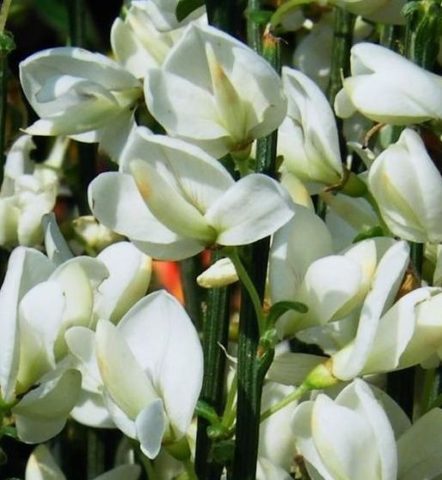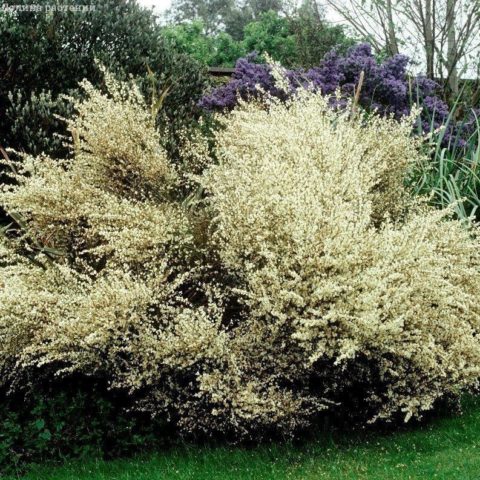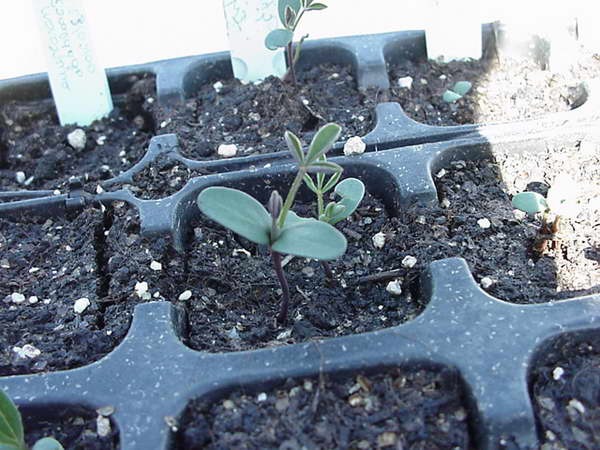Content
The broom Albus is an ornamental deciduous shrub from the legume family, known among gardeners for its abundant and very effective early flowering. It is used by landscape designers to create beautiful landscapes, in addition, the plant is considered a good honey plant, which is important for beekeepers.
Description of broom Albus
Flexible thin branches of bright green color form a dense spherical crown up to 80 cm high and up to 120 cm in diameter. Small narrow trifoliate leaves about 2 cm long are dark green in color.
Flowering begins in April, even before the leaves appear, and continues until mid-June. At this time, the shrub is abundantly covered with white flowers with a yellow tint, resembling pea flowers. There are so many of them that the thin branches of the broom take an arched shape, bending under their weight. The colder the weather, the longer flowering lasts. The corolla is about 3 cm in size. Like most brooms, the Albus variety is a good honey plant. This broom bears fruit in pods filled with small beans.
The average lifespan of the Albus broom is about 10 years, after which it gradually loses its decorative qualities and dies. Unfortunately, pruning shrubs for rejuvenation purposes is ineffective.
Winter hardiness of broom Albus
A distinctive feature of the Albus variety is its frost resistance - adult plants can withstand temperatures as low as -20 ° C, so the shrub feels good in the middle lane without shelter. Plants under the age of 3 years are less frost-resistant, therefore, in the conditions of the middle lane, they need protection from frost.
Broom Albus in landscape design
The shrub is widely used in landscape design, not only due to long abundant flowering. The plant looks picturesque the rest of the time, because the dense and spreading, drooping branches with small leaves create a beautiful crown of the correct shape. Broom Albus is used both in single and in group plantings, an interesting effect is given by several simultaneously flowering specimens of broom of different varieties. The shrub looks good in rocky gardens, goes well with conifers, ornamental grains, perennials with small flowers, as well as ground cover plants. It is often used in container plantings, forming a standard tree or lush bush. You can find this broom in hedges. This crop is also planted to strengthen the slopes.
Due to toxicity, the plant should not be planted in the immediate vicinity of water bodies, so as not to harm their ecosystem.
Growing conditions for broom Albus
For broom Albus, sheltered areas with diffused sunlight are suitable. Hot sun rays can harm the delicate foliage of the bush. The site should be open and well heated. The shrub grows poorly and blooms in the shade and does not tolerate stagnant moisture, since it belongs to drought-resistant crops.
Planting and caring for broom Albus
Broom Albus is an unpretentious plant, and with the right choice of a place for planting and soil preparation, it requires minimal maintenance. The agrotechnology of growing this shrub involves infrequent watering in dry summers, top dressing, mulching or shallow loosening, sanitary pruning after flowering, shelter for the winter of young plants.
Preparation of planting material
If the planting material is not grown independently from seeds or vegetatively, it should be purchased only in specialized stores or garden centers. Most often cuttings are sold that have reached the age of 3-4 years. Younger or older specimens of broom take root much worse. The plant should be healthy, without broken off shoots and dry leaves. It is better to purchase a seedling with a closed root system. An indicator of the readiness of a young plant to endure the winter well is the presence of lignified lower shoots.
Planting of the Albus broom is carried out by the transshipment method, i.e., together with an earthen clod. This will protect the delicate root system of the seedling from damage and significantly increase its survival rate.
Landing site preparation
The choice of a place for Albus broom must be approached with special care, since adult plants do not tolerate transplantation well.
Broom Albus prefers slightly acidic or neutral soils, tolerates calcareous substrates well. It can grow even on poor soils, but loose fertile soils that allow air and moisture to pass through are best suited, therefore, before planting, it is necessary to dig up the area with a shovel bayonet, apply mineral fertilizers for digging and prepare a substrate from peat, compost, river sand and sod land.
Landing rules
Planting the Albus broom is very simple. It is enough to adhere to the following algorithm:
- plant in spring so that the plant has time to take root before the onset of cold weather;
- it is better to plant cuttings in the evening or in cloudy weather;
- prepare planting holes 2 times larger than the root system of the seedling;
- fill a layer of drainage (broken brick or pebbles) on the bottom. The heavier the soil, the thicker the drainage pad should be;
- pour a layer of fertile soil on top of the drainage;
- place the cuttings in the hole and cover with earth to the level of the root collar;
- tamp and water the soil well;
- to mulch the near-trunk circle;
- if hot sunny weather is established, at first it is advisable to shade the newly planted plants from direct sunlight.
It is possible to transplant the broom only in extreme cases and one should act with extreme caution, since an adult plant takes root in a new place with great difficulty.
Watering and feeding
With normal rainfall, the drought-resistant broom does not need additional irrigation. In dry, hot weather, the plant is watered abundantly, but not often. Mulching allows you to reduce the amount of watering. Peat is the best mulch.
Top dressing of broom plantings is carried out twice per season. In the spring, nitrogen-containing fertilizers are applied, for example, urea, and in the summer, phosphorus-potassium complexes. To stimulate the growing season, wood ash can be added once every 2 weeks by scattering it around the trunk circles.
Preparing for winter
Only young plants up to three years of age and rooting cuttings need shelter for the winter. They are covered with dry foliage, spruce branches or non-woven material. Mature shrubs do not need shelter, but it will not be superfluous to sprinkle the trunks high with soil, peat or other organic mulch.
Reproduction
Propagation of brooms is very simple. Unlike many varietal ornamental shrubs, Albus reproduces well by seeds.Sometimes, to increase germination, the seed is pre-stratified - the beans are wrapped in cloth and kept in the refrigerator in the vegetable compartment for two months. You can do without this procedure. In both cases, in spring the seeds are soaked in warm water for 2 days, then sown in boxes filled with a mixture of peat and sand to a depth of 1 cm. The boxes are covered with glass or foil and left at room temperature. The grown seedlings are transplanted into individual containers with a substrate consisting of turf, humus soil and sand in a ratio of 2: 1: 0.5, respectively.
Transplanting into open ground is carried out in the spring, when the seedlings reach the age of two.
Reproduction of the Albus broom using cuttings is no less popular. Young green shoots are cut off after flowering and placed in a soil consisting of peat and sand. Just as when forcing seedlings, the container with cuttings should be covered with transparent material and watered periodically. After 35 - 45 days, the cuttings will take root, and next spring they can be transplanted to a permanent place.
You can use the method of propagation by layering. When an adult bush fades, the lower branches are bent down, fixed on the ground and sprinkled with soil. As early as the next spring, the rooted daughter layers can be weaned and transplanted.
Diseases and pests
Broom Albus is not very susceptible to diseases and pests. Specific pests of the broom, including the Albus variety, are the broom moth, which is controlled by dichlorvos, and the broom moth, which is sensitive to insecticides.
Black spot and powdery mildew are rare in well-groomed plants, but they pose the greatest danger; at the first signs of a disease, plants are treated with copper sulfate and Fundazol. For preventive purposes, it is recommended to spray the plants with a copper-soap mixture.
Conclusion
Broom Albus is a very promising shrub for landscaping various territories. Its long, spectacular bloom has the power to transform both private gardens and city streets. Frost resistance, unpretentiousness and resistance to diseases make it especially attractive for growing in the middle lane. The broom Albus is very hardy, it is able to survive with little or no care, but a truly luxurious flowering can be obtained only with the observance of agricultural technology.











